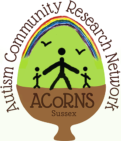Our Autism Reading Group in April focused on the topic of “Pathological Demand Avoidance” (PDA) and Autism Spectrum Condition (ASC). We had a stimulating and informative discussion on the need to understand individual differences in profiles, and how this knowledge can help schools use specific approaches to offer more targeted support.
It’s important to know that PDA is not a recognized diagnosis and the label itself is very controversial in the way that it frames people’s behavior as being non-compliant. We used the term in our discussions, but some have argued the term itself should change, maybe to ‘Persistent (or Pervasive) Drive for Autonomy’: it’s certain that more research and understanding is needed. Alexandra Harris, in the ChatLab, is studying exactly this for her PhD topic, starting from a really careful analysis of behavior in school settings, without having existing assumptions about cause.
The term Pathological Demand Avoidance has been used to describe a person who tends to avoid the ordinary demands of life, when complying is seen by others to be in their best interest. More recently, clinicians and researchers have described PDA as a behavioural profile seen in some Autistic individuals.
Our reading group highlighted three key struggles of individuals who have been given a PDA label as per their experience as being – (1) intolerance of uncertainty, (2) balancing choice and control, and (3) overwhelming demands.
All of these issues can cause great anxiety for the individual, making the usual rules and rituals of life demanding.
The group discussed how strategies useful to help autistic people manage anxiety may not be so beneficial for those fitting the PDA profile. For example, visual timetables, used to manage anxiety in autism, may make things more stressful for people with a PDA profile. The ACoRNS Voices event last year had a really powerful expression of this from one of our speakers, Marysia https://www.youtube.com/watch?v=faJlG-oKsos
We talked about how PDA can be manifested by using social strategies to avoid demands and to mask anxiety or underlying processing and communication issues. It is important to research, share and assess different strategies teachers might use to support children with this profile at school, given how many demands are involved in everyday school activities.
PDA not as prominent as the child grows up
Some attenders suggested that the PDA profile diminishes over time – Is there then a need for a label? Why would you have a PDA at one point and not another? Our discussion indicated that this might be because as you get older you have more control, influence, predictability and certainty; all factors that help reduce anxiety, diminishing demand-avoidant behaviours. This gives us clues about how to shape strategies for PDA profiles. This can also help us understand the importance of pre-empting or trying to spot early signs before the situation becomes unmanageable.
The problem with pathologizing
It is unclear how useful the term can actually be. Members of the ARG discussed how the term implies that the ‘problem’ is in the child in not meeting everyday demands. Can we re-think PDA as a response to the limitations of education and training systems? One member said the term ‘pathologizes’ an autistic person’s preferences and autonomy and is not a clinically useful way to understand difficulties.
How to give advice to schools without addressing labels?
We discussed the importance of teacher training in being able to offer tailored support. Sometimes no-demand or low-demand approaches are used: ways to request an action without causing anxiety or avoidance. One person suggested graded scripts varying from low to high demand. We discussed times when teachers might have to make a demand on the child to ensure their safety; advice on this could also be provided in these scripts. These tools could truly help the teachers successfully communicate with the individuals.
The group discussed the need for teachers to be adaptable with their approaches. A member mentioned the STAR model and how this could be used to implement reasonable adjustments.
STAR refers to ‘Setting, Trigger, Action, Response’. Teachers can use this method to break down and analyze what may have caused a meltdown or a panic attack, and then adjust their approaches to be able to help the individual.
Group training sessions could also be a useful tool to collaboratively come up with ways to speak to the children without actually placing any demands on them. Although scripts would be beneficial for individual use, these sessions would allow teachers to discuss approaches that have been helpful to others and learn from each other.
Overall, the importance of trusting relationships and ‘connection before correction’ was particularly emphasized. One proposal was that young people need to develop the idea that it is safe to let someone else take control.
We ended up with more questions than answers: what techniques do teachers use, how effective are they, what is really behind PDA-type behaviors, how do these patterns change developmentally? More research is needed.
Sources
Hess, P. Spectrum Autism Research News 2022, August 11. Pathological demand avoidance in autism, explained
McElroy, R. (BPS: 2015, December 8) PDA – is there another explanation?
Newson E, Le Maréchal K, David C. (Arch Dis Child. 2003 Jul;88(7):595-600. doi: 10.1136/adc.88.7.595. PMID: 12818906; PMCID: PMC1763174) Pathological demand avoidance syndrome: a necessary distinction within the pervasive developmental disorders.
